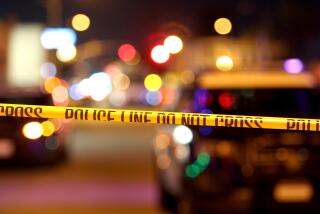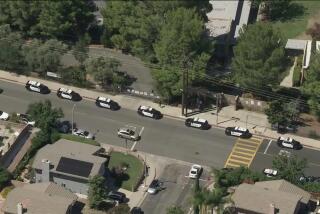Shooting Shatters Perception of a Community : Crime: Gunfire at an outdoor party left a bystander blinded in one eye. Residents of the affluent neighborhood, which seemed immune from violence, are now searching for answers to teen-age problems.
PACIFIC PALISADES — Violence isn’t supposed to happen in Pacific Palisades. When it does, many residents are quick to assume that “outsiders,” “gangs” or “the bused-ins” are to blame.
But earlier this month, the affluent, mostly white neighborhood was shaken by a shooting that police say was home-grown. An argument broke out at an informal outdoor party at the end of Los Liones Drive in the hills north of Sunset Boulevard, and escalated into gunfire. Two bullets struck a car, sending shards of glass and metal into the face of a bystander, a Palisades High School senior who may be permanently blind in one eye.
On the scale of urban violence, it was no big deal. But to those who thought of the Palisades as one small corner of Los Angeles that was immune to such incidents, it was a rude surprise.
The incident also has focused the attention of parents, police and school officials on the parties that have become a social staple among the area’s youths. The impromptu gatherings take place on weekend nights, usually in cul-de-sacs in the hills, and involve up to several hundred teen-agers and young adults who hang out, drink and use drugs ranging from marijuana to LSD.
Police, who say they view the Sept. 6 shooting as an isolated incident, have arrested and charged two suspects with assault with a deadly weapon: Todd Gilbert, 19, of Pacific Palisades and Adrian Gunderson Williams, 22, of Malibu. Both are free on $40,000 bail each and are scheduled for arraignment Oct. 15. Police said two other men who were in the car with them are still being sought. They have not disclosed which suspect owned or fired the gun.
The victim, Chad McClellan, 18, has lost vision in one eye, although doctors are hopeful that he will eventually regain some peripheral vision.
In the wake of the shooting, police say they are monitoring the canyon gatherings and dusting off Los Angeles’ little-enforced teen-agers curfew law. Teachers and students are discussing the incident and the dangers of unsupervised partying.
Reaction among the youths who witnessed the shooting ranges from shrugs (“Big deal, I’ve seen it before”) to alarm (“No more big outdoor parties for me!”).
Some parents, meanwhile, say the incident underscores the need for community action to provide alternatives, echoing the concern sparked five years ago when four youths, including the son of U.S. trade representative Mickey Kantor, died in a fiery automobile crash after a night of partying. At least a dozen Palisades youths have suffered violent deaths, many of them involving alcohol or drugs, during the last six years, including a 15-year-old who was shot to death in 1987 at the same Los Liones site as this month’s incident.
“The whole system I participated in as a teen-ager is not available to these kids,” said Melodye Kleinman, a mother of three. “There are no jobs, no night ballgames, no dances. Kids want to hang out somewhere.”
On the night of the shooting, about 100 teen-agers converged on an isolated piece of land at the end of Los Liones Drive. Many had gone to a private party in the area, which broke up after neighbors complained about the noise and a passing car bumped one youth in the street outside the home. The group drifted up Los Liones.
Shortly after 11 p.m., according to Los Angeles Police Lt. Ross Moen, commanding officer of West Los Angeles detectives, a carload of youths drove up in a BMW, letting it be known that they had a dispute with another local youth and were looking for him. Fearing trouble, someone asked them to leave and they drove off, opening fire, Moen said.
McClellan, who had nothing to do with the dispute, was the only teen-ager wounded. Friends drove him to the hospital.
To police, the mass parties are a minor problem, Moen said. “But at the point where there is a shooting, we have a major problem.”
“I’ve been expecting something like that to happen,” said a 20-year-old who witnessed the shooting and agreed to talk--as did other witnesses--on condition of anonymity. “Things are getting more violent, and there are a lot of Pali kids out there who really don’t have a good sense of what is going on. The ones with guns are among the most naive. It used to be that kids would fight one on one; now 30 kids’ll mob on one or break out a weapon.”
“Disgusting,” added his 19-year-old friend. “These kids think they have to prove something. They’re a bunch of little rich kids who see violence on television. . . . They’re pretty sick.
“It makes me angry,” said a 16-year-old girl who was at the party. “It doesn’t surprise me that kids that age have access to guns, but it makes me mad that other people can get injured in what started off as a normal guy fight.
“It frightens me . . . but it’s not going to affect where I go or what I do. I’m not going to stay cooped up in my house. . . . This is a warning--not that you should not go to places where you usually go, but that you have to watch your back. Any time you have 200 kids partying, most of them drinking or on drugs, something is gonna happen.”
Steve Cunningham, the LAPD’s senior lead officer for Pacific Palisades, said the large parties are “not usually that big of a problem.” Teen-agers use the canyons and dead-end roads as a place to meet and drink, and “raise Cain,” he said, and police drive by the regular spots “as often as we can” to see what they are up to. They make a few narcotics arrests, and advise youngsters gathered after curfew to leave.
Los Angeles has a curfew law that requires minors who are unaccompanied by an adult to be off the streets by 10 p.m. unless they can show they are on their way to or from a legitimate activity, such as an athletic event or movie.
Overall, he said, the party problems actually appear to have abated over the last year, although there are occasional arrests for curfew violations, vandalism, underage possession or consumption of alcohol, narcotics and disturbing the peace. So far, he said, no weapons have been confiscated.
At nearby Palisades High School, where some of the party-goers are students, Principal Merle Price emphasized that the shooting incident was not school-related and involved students from private schools and other public schools. (Witnesses, however, said the teen-ager sought by the youths in the car is a Palisades High senior).
Nonetheless, Price said, “We talked with the few who go here in small groups about gathering in unsupervised areas and we counseled parents about the need for supervision.
“Our concern is that there be no further repercussions on campus. We asked the kids to keep us informed and we alerted the school police.”
Parents say they feel frustrated and helpless: their youngsters drive and may be coming home from a movie when the group decides to cruise the canyon in search of a party. They feel they can’t forbid a 17-year-old to hang out with his friends--or enforce such an order. They say teen-agers need activities that allow them to socialize, such as church and community service projects and part-time jobs after school, as well as organized weekend activities--and that centers for teen-agers do not provide the answer.
The parents also say that police need to make their presence felt, and that more parents should allow their children to party at home, with adults on the premises, instead of making the remote cul-de-sacs their only option.
“The neighbors may hate me,” said one mother of three boys, “but I don’t chase the kids from their radios and cars and hanging out on my corner. I’ll chase them if I see drugs, but if they want to hang out and play music, that’s fine.”
Dr. Carl Utsinger, a Westside psychiatrist who works with teen-agers and is a parent, suggests that parents band together for mutual support and information-sharing--such as letting each other know when they are planning a trip, since the largest and most boisterous parties often take place when parents are out of town.
He cautioned parents not to conclude--with mistaken relief--that their teen-agers no longer require the time and supervision younger children do. “They need as much or more . . . and they can be quite a package to deal with.
“Teen-agers often get lost in the cracks,” Utsinger said. At a time when after-school programs and extracurricular activities have been eliminated or scaled back by schools, recreation departments and other organizations, teen-agers are often left to devise their own strategies to occupy time.
Besides parents meeting in small groups, Utsinger suggested that the community explore--through churches, the city, parks and other organizations--what alternatives it can offer teen-agers. “There are not many jobs out there for kids,” he said, “yet most of these parents are successful and could use their influence with their own companies to find some after-school spots.”
Early parent-child relationships build a platform for later interaction when teen-agers announce that they are going “out” and will return “later,” Utsinger said, and suddenly starting to set rules is bound to be viewed as intrusive. “Mom has been on snooze alarm for years with her daughter and then something obvious (such as the shooting) goes on . . . and suddenly she expects to have a big say about curfew.”
More to Read
Sign up for Essential California
The most important California stories and recommendations in your inbox every morning.
You may occasionally receive promotional content from the Los Angeles Times.










